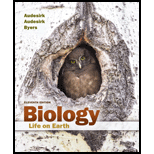
Concept explainers
The physical position of a gene on a chromosome is its _______ slightly different forms of a gene are called_________.
a. locus; alleles
b. locus; polygenic
c. chiasma; alleles
d. trait; hybrids
Introduction:
Genes are the primary structural and functional units of heredity. These are basically the sequences of nucleotides containing the bases, namely; A (adenine), T (thymine), G (guanine), and C (cytosine). Genes are precisely located on the chromosomes. Mutations in the genes often lead to the deoxyribonucleic acid (DNA) damage or the disruptive phenotypic traits.
Answer to Problem 1MC
Correct answer:
Locus is being defined as the position where the gene resides on chromosomes. Also, the alleles are known to be the variable forms of genes.
Explanation of Solution
Explanation for the correct statement:
Option (a) given for the definition of locus: The place where the genes are located along with the definition of alleles: The unidentical form of the genes is correct. As, the locus is generally defined in a way as the definite position at which genes are located on the chromosomes, whereas allele is the unidentical forms of the gene present on different chromosomes. Therefore, this option is correct.
Explanation for incorrect answer:
Option (b) as given for the definition of the locus, is the position at, which genes are placed, is correct. On the contrary, variable forms of genes are called polygenic. The term ‘polygenic’ governs two or more than two genes on a single phenotypic character. So, it is the incorrect answer.
Option (c) defined the locus as the position at, which chiasma is placed, along with the definition of an allele as the variable form of the genes. As chiasma is defined as the point at, which the information gets exchanged between the chromatids that are also known as chromosomal crossing over. So, it is the incorrect answer.
Option (d) provided the definition of the locus as the position where traits are placed on chromosomes, and different forms of a gene to be the hybrids. Traits are described as the unique characteristics in an individual which makes one person different from the other in many forms and features, and hybrid is formed when the parents involved are from different species or subspecies. So, it is the incorrect answer.
Hence, option (b), (c), and (d) are incorrect.
Therefore, it can be concluded that genes carrying the information in the form of bases, codes for different proteins are found at a specific place on the chromosome known as a locus, and the unidentical forms of the genes are known as alleles.
Want to see more full solutions like this?
Chapter 11 Solutions
Biology: Life on Earth (11th Edition)
- What are intrinsically disordered proteins, and how might they be useful for a living system?arrow_forwardWhat are Amyloid Fibrils? What biological functions are these known to perform?arrow_forwardHow do histamine and prostaglandins help in the mobilization of leukocytes to an injury site? What are chemotactic factors? How do they affect inflammation process?arrow_forward
- Compare and contrast neutrophils and macrophages. Describe two ways they are different and two ways they are similar.arrow_forwardDescribe the effects of three cytokines (not involved in the initial inflammation response). What cells release them?arrow_forwardDescribe activation of helper T cells or cytotoxic T cellsarrow_forward
- Compare and contrast MHC 1 and MHC 2. Describe two way they are different and two ways they similar including how they are used in antigen presentation.arrow_forwardDescribe two antimicrobial properties of the skin.arrow_forwardDescribe how the inflammation response starts including the sentinel cells and the chemicals involved. How do pathogens trigger the response particularly in the skin?arrow_forward
- How does complement promote the immune response? Describe three waysarrow_forwardWhich of the following is not a possible mechanism for autoimmunity? Select one: A. Abnormal expression of MHC II molecules in non-antigen-presenting cells B. Activation of polyclonal B cells C. Polymorphism of HLA alleles D. Molecular mimicry E. Release of sequestered antigensarrow_forwardWRITTEN WORK 3: NON-MENDELIAN GENETICS Part A: Complete the Punnett square and calculate for the probability of genotype and phenotype. i i Genotype: Phenotype: 08:55arrow_forward
